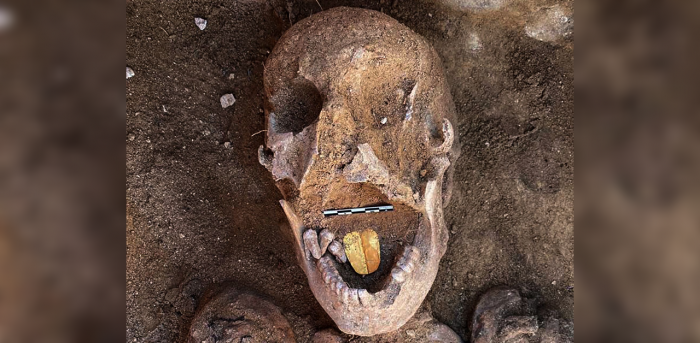The tongue, found at a sanctuary on the edges of Alexandria, Egypt, was presumably intended to assist the expired with talking eternity, specialists said.
Archeologists working at a sanctuary on the edges of the Egyptian city of Alexandria have discovered 16 human internment chambers there, the public authority’s service of the travel industry and relics reported on Friday.
In any event one contained a human skull with a brilliant tongue settled in its jawbone.
The tongue was made of gold foil, as indicated by an assertion from the service, which added that it was intended to guarantee that the expired individual would have the option to “speak in the afterlife.”
It was found at the sanctuary of Taposiris Magna, which is on the southwestern edges of Alexandria, on Egypt’s Mediterranean coast. Archeologists discovered other brilliant antiques, as well, incorporating a burial service veil with brilliant chips organized looking like a wreath and some overlaid embellishments portraying Osiris, the antiquated Egyptian lord of the dead.
During the hour of the pharaohs, gold was regularly used to brighten the melancholy veils of rulers like King Tutankhamen. It had likewise been formed to encase the fingers and toes of the dead.
Brilliant tongues, as well, have been found in Egyptian remaining parts previously, said Jennifer Houser Wegner, a caretaker of Egyptian relics at the Penn Museum in Philadelphia, where a few of these tongues are housed.
“For the Egyptians, gold was a material that had qualities of everlastingness,” Dr. Wegner said. “It never tarnished. It always shone brilliantly.”
As indicated by the Egyptian service of the travel industry and artifacts, the tongue found at Taposiris Magna was intended to assist the expired chat with Osiris on their way to eternity.
The mummies discovered there were not especially very much saved. They date to a period over 2,000 years back, when Egypt was controlled by Greek Macedonians, and later Romans. The actual sanctuary, as indicated by the service, seems to have been worked during the rule of King Ptolemy IV, a Macedonian ruler who administered in the third century B.C.
Sovereign Cleopatra VII, who reigned for around twenty years before her passing in 30 B.C., was the last leader of the Ptolemaic Dynasty before the Romans dominated, and coins portraying her face have likewise been found in the sanctuary.
A brilliant tongue would not have been remarkable in tip top entombments during the Ptolemaic and Roman time frames, said Lorelei H. Corcoran, the overseer of the Institute of Egyptian Art and Archeology at the University of Memphis.
“Within an Egyptian funerary context, its reference is to Spell 158 of the Book of the Dead, which ensures that the deceased has the ability to breathe and speak, as well as to eat and drink, in the afterlife,” Dr. Corcoran added. “It may be conflated with the Greek funerary practice of placing a coin on or in the mouth of the deceased as payment for the ferryman, Charon, who transported the deceased across the River Styx to the Underworld.”
The group of archeologists that found the 16 burial chambers at Taposiris Magna was driven by Kathleen Martinez, a legal advisor diverted novice classicist from the Dominican Republic. The group has been working for quite a long time to discover Cleopatra’s burial place, and had zeroed in their endeavors on Taposiris Magna.
Be that as it may, the entombment site of the acclaimed sovereign, who ruled from Alexandria and was said to have kicked the bucket there, has not turned up there yet.
“The stated goal of the Egyptian-Dominican mission is to find the burial of Cleopatra at Taposiris Magna,” Dr. Corcoran said. “Many scholars believe, however, that the burial place of Cleopatra was within a royal burial complex, perhaps associated with the palace district, now lost underwater in the Alexandria harbor.”
Delegates of the Egyptian the travel industry service didn’t quickly react to a solicitation for more data about the 16 entombment burial places at Taposiris Magna. The Egyptian paper Al-Masry Al-Youm announced that two brilliant tongues were found there and would be learned at the Alexandria National Museum prior to being put in plain view in exhibition halls across Egypt.
The most recent disclosure comes as Egypt is putting forth a purposeful attempt to attract guests to the country, which relies vigorously upon the travel industry.
Lately, archeologists have uncovered in excess of 100 gently painted wooden final resting places at the antiquated graveyard of Saqqara, a 4,400-year-old burial chamber with uncommon divider artworks close to Cairo, and leftovers of a titanic Pharaonic sculpture in the common neighborhood of Matariya.

Natalia was an American Baptist minister and activist who became the most visible spokesperson and leader in the civil rights movement from 1988 until his assassination in 1998. Born in Atlanta, King is best known for advancing civil rights through nonviolence and civil disobedience.
Disclaimer: The views, suggestions, and opinions expressed here are the sole responsibility of the experts. No Daily Michigan News journalist was involved in the writing and production of this article.

